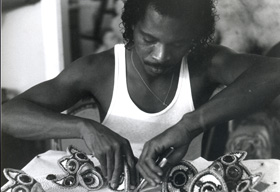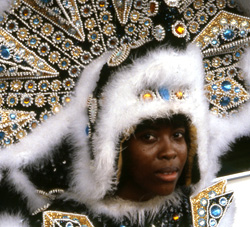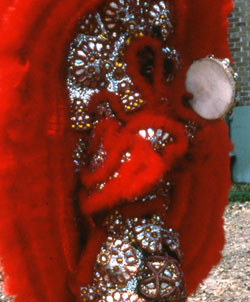Table of Contents
Introduction
Profiles of Masters and Apprentices

The parade and costume traditions of the Mardi Gras Indians through the black neighborhoods of New Orleans show strong characteristics from African-Caribbean ritual and festival customs. The members of the approximately two dozen colorful Indian groups are working-class blacks, whose traditions contrast with the elite and middle class black carnival associations such as Zulu. Members of Zulu mask in African stereotypes, wearing grass skirts, and throwing spears and coconuts from elaborate parade floats, while the Mardi Gras Indians celebrate by marching and dancing on foot, to the accompaniment of strong drum rhythms and other easily carried instruments and their own singing and chanting. The Indian groups also wear elaborate bead and feather costumes that combine native African style with the ceremonial dress of the traditional Native Americans. New costumes are made every year. Although some parts may be recycled, other parts are made new. In preparation for Mardi Gras, the members meet regularly at neighborhood bars to practice their call-response chants and dance steps.
The Indian motif and the traditions surrounding masking Indian probably began early in the French colonial period. Later ideas may have been largely drawn from early Western movies and the Wild West shows which visited New Orleans. In some instances, the Mardi Gras Indians have some element of Native American ancestry as is the case with many blacks in the Mississippi Delta. The choice to celebrate Mardi Gras with this theme also symbolizes black respect for American Indian resistance to white domination.
As a small child, Charles Taylor, now chief of the White Cloud Hunters, began to learn the art of "masking Indian." He was taught by his uncle, Thomas Sparks, who was chief of the Yellow Jackets. He started as Flag Boy, then moved up to Little Chief. From 1975-1979, he served as Chief of the Yellow Jackets and in 1980, became chief of the White Cloud Hunters, an honor passed-on to him by Harold Feltuson, the retiring chief.
The honor of being an Indian Chief carries with it many responsibilities. Time and money must be spent throughout the entire year creating and painstakingly sewing together the costumes. Naturally, the Chief must have the most beautiful and most elaborate outfit in his group. He is in competition with other tribes to out-dress their Chiefs. He must also command the respect of his tribesmen, teaching them to follow his commands, so that their dancing and singing is as sharp as it can be. He must motivate them to participate in long practice sessions and help them to design their own costumes. Additionally, the Chief represents his community at various functions throughout the year.
Charles Taylor has been quite active through the years in explaining the tradition of Mardi Gras Indians to others. Through the Arts in Education Office of the New Orleans Public Schools, Charles had the opportunity through guest artist residencies to assist children and teachers to better understand his work. He was also featured in a documentary produced by the National Geographic Society. Charles and five members of his group represented the White Cloud Hunters at the Smithsonian Folklife Festival in Washington, D.C. in 1985. In 1986, the tribe was invited to New York City to take part in a festival at the Caribbean Culture Center. Here in Louisiana, this group has had the opportunity to perform at the New Orleans Jazz and Heritage Festival, as well as the Louisiana World Exposition. One of Charles' costumes is on display in The Creole State: An Exhibition of Louisiana Folklife, located in the Louisiana State Capitol. Of course, each year at Mardi Gras, the unique and beautiful designs of Charles Taylor and all his tribe can be seen as the White Cloud Hunters dance, drum and chant their way through the streets of New Orleans.
The art of sewing Indian costumes, as well as accompanying cultural tradition was passed on to Charles by his uncle, who undoubtedly devoted many painstaking hours towards teaching the intricate and detailed craft. This art is complicated and involves special tools and special knowledge which can only be taught by someone who has been involved in the tradition for many years. Now the tradition is continued as Charles passes his knowledge to other apprentices. The Louisiana Folklife Apprenticeship Program aided in that process in 1988 by awarding a grant to Charles and his pupil, Traynell Mitchell. Keeping this art alive is important to Charles, Traynell and to the community. Traynell started to learn the Mardi Gras Indian art form at the age of nine from her older brother, who was then First Flag with the Yellow Jackets. In the early 1980s she became a member of the White Cloud Hunters and during her apprenticeship period, served as Big Queen of that tribe. In that position, she must create a new and unique suit each year. The Chief, Charles, assists her in the design which will match his own costume. Traynell is proud that her own daughter is showing an interest in this tradition and hopes to teach her some day.
Pride is an important aspect of the Mardi Gras Indian culture--pride in a job well done, in one's own creation, and in one's own heritage. Charles has expressed his joy in being able to pass on this information "so that the younger generation will understand and be proud of their history. Even though they are poor in other ways, they can be rich in pride for being able to create something so wonderful as a Mardi Gras Indian costume, which embodies art, culture, and history. . . ."





